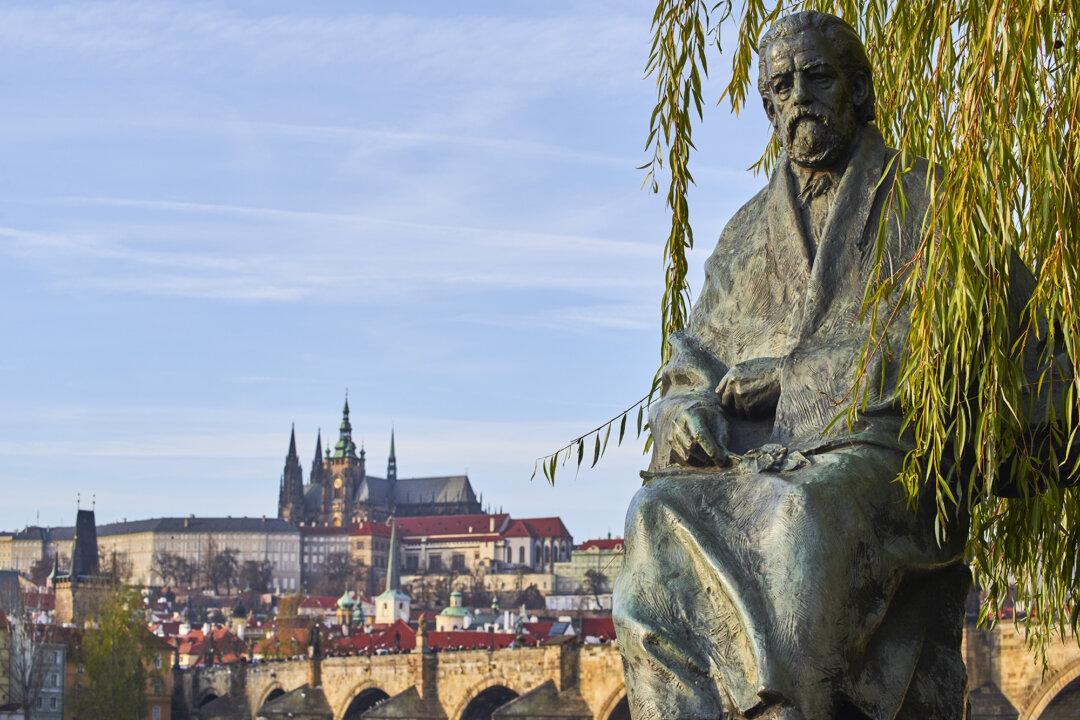As we press deeper into the rainforest, further down an undulating path, under an ever-denser, darker canopy, the creepy-cool creatures reveal themselves, one at a time.
First, a giant morpho butterfly, its wings flashing bright purple, skimming just above the path, and our heads, fluttering in a rush, like it was late for an appointment. Then, off to the right, a black, spiny-tailed iguana, just hanging out on a tree limb.
The last two are deep in the green, and I start to think we’re in the middle of “Pan’s Labyrinth.” Up high, spotted by our guide, we crane our necks to see a three-toed sloth, lolling on his back, his huge, curved, almost-comical claws above him, gripping the tree. And then—almost too close for comfort, right next to the path—a big boa constrictor, just his head and neck visible, lurking a few feet away, mostly camouflaged by the lush jungle foliage. Although he doesn’t pose a threat to us (not much, anyway), I’m happy to emerge back into the sunlight, our little hike finishing at a small beach on a hidden cove, the waves rolling in from the Pacific.
I’m at Manuel Antonio National Park, Costa Rica’s smallest national park, and one of the most biodiverse places on earth. The park’s 5,000 acres are home to almost 200 species of birds, more than 100 types of mammals (including four kinds of monkeys, two types of sloth), plus all sorts of snakes, bats, and frogs. But it’s a place located far from the big beach resorts—and consequently seen by only a fraction of the visitors to this Central American nation.
Just reopened in November, Costa Rica is welcoming the world, no quarantine required. While some will come seeking only sun, and sand, and zip-lines, it’s a place that rewards those who search for more. Hire a driver-guide (or if you’re even more adventurous, rent a car) and travel up and down the coast, and deep into the interior. From tumbling waterfalls and steaming volcanoes to spots where you can leap from a cliff (and scream as much as you like), here are some of the best places to explore in the land of “pura vida” (the national slogan, which is all about living the pure life).
The Tarcoles River
A serpentine river emptying into the Pacific on the central coast of the country, the Tarcoles is filled with crocodiles. Come down on the Pan-American Highway, and head out in a covered safari boat. You can spot them, swimming, dark and mysterious, in the brown, brackish flow, or sunning themselves, hauled out on the banks, mouths wide open, their rows of fearsome teeth flashing in the sun. Bordered by Carara National Park, the skies over this part of the river are also busy with all sorts of tropical avian life, storks and hawks and herons and egrets, swirling above and landing in the wetlands, with care.Guides know the biggest and oldest crocs on sight (including one that’s massive, grizzled, and battle-hardened, and lived to the age of 80), and you’ll want to keep your hands and arms inside the boat.
The Ultimate Waterfall Rappel

Courtesy of Pure Trek
A series of four drops, here a company called Pure Trek takes you to the top of a canyon near the flanks of the Arenal Volcano and dares you to swing and rappel down cliffs as high as 15 stories. In the process, guides sometimes like to swing you right into the cold cascade of a 165-foot waterfall. You’ll get the worst out of the way at the start—the first one is the highest. But the “monkey drop” might be the most thrilling, a controlled free-fall that finishes, with a splash, in a natural pool. (Guides remind you to monitor your screaming, lest you get a mouthful of water at the end of the ride.)
La Fortuna and Arenal
A popular tourist town, La Fortuna serves as the hub for a number of jungle adventures. Set in the shadows of Arenal, it is still an active volcano—you can spot steam rolling out of the top of its summit, a picture-perfect green cone. Come here to get your heart pounding, crashing down rivers while white-water rafting or soaring over the top of the canopy on a zip-line. Those looking for an aerial view at a more manageable pace should check out the Sky Tram, which coasts slowly up the side of a mountain to an observation deck, allowing you to snap photos of nearby birds and howler monkeys.Then, when you’re ready to dial it down, head to Tabacon Thermal Resort, which offers a series of geothermal hot springs and waterfalls—grab a drink from the swim-up bar and relax with a guaro sour, the national cocktail, or an Imperial, the national beer.
San Jose

Central Market. Krummerchen/Shutterstock
Many visitors bypass this bustling, Latin American capital on the way to the beach. But it’s worthwhile to tarry for at least a day or two. Walk the Plaza de la Cultura, the main square, filled with fountains, as well as street performers, and bordered by the national theater.
Browse everything from fresh local produce to coffee at the nearby Central Market, which dates back to the 1880s, exploring its passageways hung to the ceiling with goods from all over the country. Then, sit down for a traditional dish (think: rice and beans, for about two bucks) at one of the “sodas” (slang for snack bar) inside. And at the Pre-Columbian Gold Museum, curated by the central bank, you can take in thousands of objects, a journey through the country’s history, seen through the lens of its most valuable export.
Miravalles Volcano
Remote, near the Nicaraguan border, the nearby Las Hornillas hot springs steam and bubble. Fun for a walk past the steam vents and boiling pots, the main thing here is the mud. Mineral-rich and warmed by the earth itself, the stuff is said to have restorative properties, and you’re encouraged to apply it everywhere, from head to toe. Slather yourself up and take an almost-unrecognizable photo, then soak it off, the right way, in one of their warm pools.Golfo Dulce and Playa Cativo

Dolphins on the Golfo Dulce. Tim Johnson
This rare tropical fjord in the south of the country, near the Panamanian border, is an aquatic wonderland bookended on each side by nature preserves. Take a boat ride to spot humpback whales and, if you’re lucky, a pod of dolphins will come to play, pacing the vessel and tracing its wake, leaping from the water and putting on a show, before you jump from the side to swim to an abandoned beach.

Remote Cativo Beach, Costa Rica. Courtesy of Playa Cativo

Sunset bar, at Playa Cativo, Costa Rica. Courtesy of Playa Cativo
And stay the night—or the week, or the month—at Playa Cativo, an off-the-grid eco-resort with 18 casitas. Powered entirely by solar and hydro, you can dine on fresh fruit, veggies, and chicken from their on-site gardens and seafood from the gulf, or enjoy a massage at the spa. Then take a swim in their chemical-free pool, the waves lapping nearby, the real world a million miles away.
If You Go
Check out Manuel Antonio National Park at ManuelAntonioPark.comToronto-based writer Tim Johnson is always traveling, in search of the next great story. Having visited 140 countries across all seven continents, he’s tracked lions on foot in Botswana, dug for dinosaur bones in Mongolia, and walked among a half-million penguins on South Georgia Island. He contributes to some of North America’s largest publications, including CNN Travel, Bloomberg, and The Globe and Mail.





